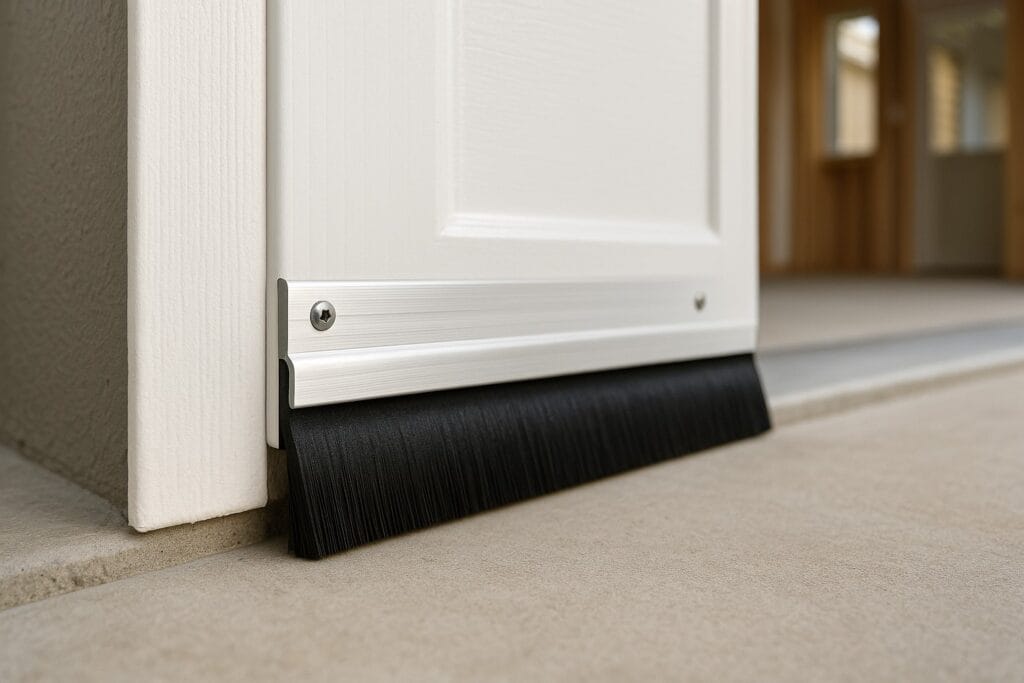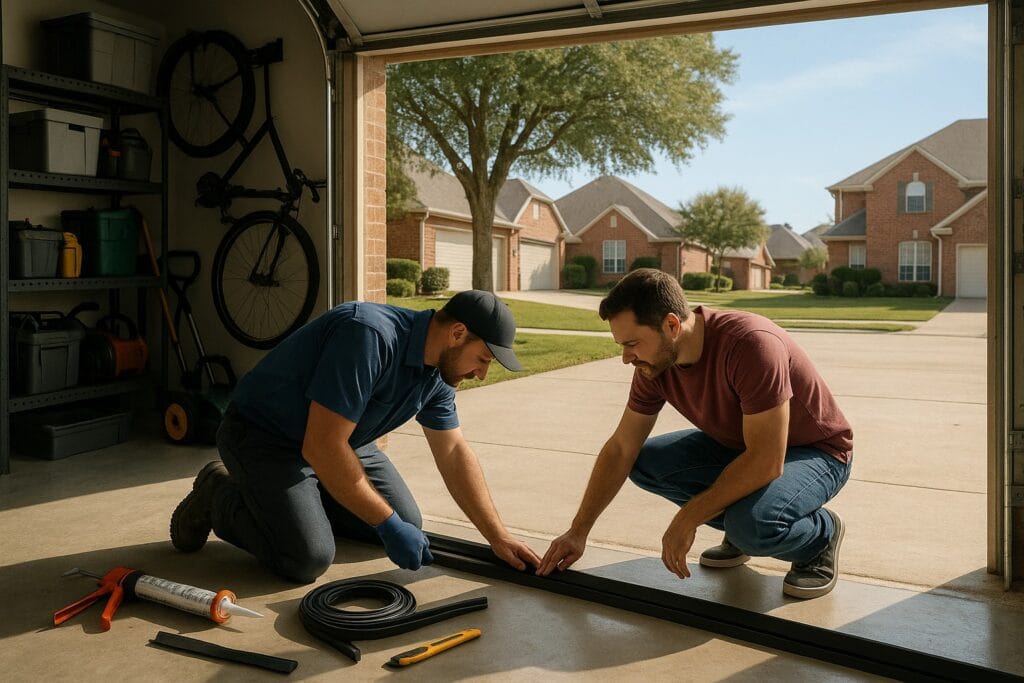In Austin, the weather can shift quickly from blazing summer heat to sudden thunderstorms, leaving homeowners searching for ways to keep their garages dry, comfortable, and energy efficient. At Ramsey Garage Doors Co., we recently worked with a family in North Austin whose garage was constantly filling with water after every rainstorm. The problem was traced back to worn and cracked weather stripping along the bottom of their garage door. Once we installed a new bottom seal combined with a threshold seal, the garage remained dry, their tools stayed safe from water damage, and the family noticed lower energy bills within just a few weeks.
This is not an isolated case. According to the U.S. Department of Energy, nearly thirty percent of a home’s total energy loss happens through doors and windows. A garage door without proper weather stripping can account for a large portion of that loss, especially in climates like Austin, where both extreme heat and sudden rain are common. With the right garage door weather stripping in place, homeowners can block cold air in the winter, hot air in the summer, and moisture during storms while also keeping out pests and dust.
For many homeowners in Austin, garage door weather stripping is not just an optional add-on. It is an essential part of keeping the home safe, energy efficient, and well-protected from outside elements. A tight seal around the garage door can make a noticeable difference in comfort levels, energy bills, and even the overall life span of your garage door and opener system.
Why Weather Stripping Matters for Austin Homes
Weather stripping serves as the barrier between the outdoor climate and the inside of your garage. It fills in the gaps that naturally occur between the garage door and the frame, floor, or side walls. In Austin, these gaps can let in extreme heat during the summer months, cold air during winter nights, and moisture during seasonal thunderstorms. Without a proper seal, even small gaps along the bottom or sides of the door can allow unwanted air, water, or pests to sneak inside.
For many homeowners, the first sign that something is wrong is a sudden increase in energy bills. Air conditioning units and heating systems often work harder than necessary when garages are not sealed properly. Over time, this can lead to wear and tear on HVAC systems and higher monthly costs. Another common problem in Austin is water damage caused by heavy downpours that leave moisture pooling on the garage floor. This water can seep into cracks in the concrete, causing long-term corrosion or even foundation damage.
A tight seal also helps protect against pests. Rodents and insects often enter garages through small openings in the door. Once inside, they can cause significant damage by chewing through insulation, wires, or stored belongings. For homeowners who use their garage as a workspace, fitness area, or extended living space, keeping pests, dust, and drafts out is even more important.
Different Types of Garage Door Weather Stripping
There are several different types of weather stripping available for garage doors. Each type is designed to handle specific problems, and the right choice depends on the unique needs of your home, the condition of your garage, and Austin’s unpredictable climate. Below are the most effective types of garage door weather stripping and their benefits.
Bottom Seal
The bottom seal is one of the most important types of weather stripping. It is designed to create a tight barrier between the garage door and the concrete floor. This seal is often made of rubber or vinyl, and it compresses when the door closes.
The main advantage of a bottom seal is its ability to block drafts, moisture, and pests from entering the garage. In Austin, where driveways may slope toward the home, a bottom seal prevents rainwater from flowing directly inside. It also helps keep dust and debris from blowing into the garage during windy days. Homeowners should check their bottom seals regularly since they often wear down from years of opening and closing the door.
Threshold Seal
A threshold seal is installed directly on the garage floor rather than on the garage door itself. This creates a raised barrier that water cannot easily cross. Made from durable rubber materials, threshold seals are excellent for protecting against flooding during Austin’s intense thunderstorms.
Threshold seals also help improve energy efficiency by creating an airtight fit against the bottom of the garage door. When combined with a bottom seal, this creates a double layer of protection. Many homeowners who live in low-lying areas of Austin or have garages that sit slightly below driveway level find threshold seals to be the perfect solution for preventing water damage.
Door Stop Weather Stripping
Door stop weather stripping is attached to the top and sides of the garage door frame. It consists of flexible vinyl or rubber strips that press against the door when it closes, forming a snug seal.
This type of weather stripping is especially helpful for older homes in Austin, where foundations may have shifted over the years, creating small gaps along the edges of the door. By sealing the sides and top, door stop weather stripping prevents air leaks and reduces drafts. For homeowners with living spaces connected directly to the garage, this can make a big difference in indoor comfort.
Brush Seal
Brush seals are unique because they use thick bristles instead of solid rubber or vinyl. The bristles sweep against the floor or sides of the door to block dust, dirt, and pests while still allowing a small amount of airflow.
In Austin, brush seals are particularly useful for commercial garages, auto shops, or homes located near busy roads where dust levels are high. While they are not the best solution for keeping water out, they provide excellent long-term protection against debris and insects. Homeowners who want to maintain airflow in their garage without letting pests inside may benefit from brush seals.

Vinyl and Rubber Weatherstripping Kits
For homeowners looking for a complete solution, weatherstripping kits offer everything needed to seal the garage. These kits typically include bottom seals, top seals, and side strips made from vinyl or rubber.
They are affordable and relatively simple to install, making them popular for do-it-yourself projects. However, vinyl materials can become brittle in extreme temperatures, so homeowners should select high-quality options that can withstand Austin’s hot summers and sudden cold fronts.
Garage Door Panel Weather Stripping
Some older garage doors, especially wooden models, have gaps between panels that allow light, air, and water to pass through. Panel weather stripping involves placing thin foam or rubber strips between each panel.
This method is ideal for extending the life of an older garage door without replacing it entirely. For homeowners in Austin who want to preserve the character of a wooden door while improving insulation and energy efficiency, panel weather stripping is an effective option.
Factors to Consider Before Choosing Weather Stripping
Before selecting the right weather stripping for your garage door, it is important to evaluate several factors.
Austin’s Climate: Austin experiences extreme temperatures in both summer and winter. Rubber and premium-grade materials with UV protection tend to last longer in direct sunlight. For water protection during thunderstorms, threshold seals are often the best choice.
Condition of the Door: If your garage door is cracked, warped, or damaged, even the best weather stripping may not provide a perfect seal. In such cases, garage door repair may be necessary before installation.
Material and Longevity: Rubber is highly flexible and creates an excellent seal against water. Vinyl is affordable and easy to install, but it may not hold up as well in Austin’s climate. Brush seals provide long-lasting protection against dust and pests.
Signs Your Weather Stripping Needs Replacement
Weather stripping naturally wears out over time. In Austin, where climate conditions are intense, many homeowners need to replace it every two to three years. Some clear signs that it is time for replacement include:
- Cracks, tears, or brittleness in the seal material.
- Visible daylight showing around the edges or the bottom of the garage door.
- Water pools inside after storms.
- Drafts and temperature swings in the garage.
- Higher energy bills than normal.
- Increased presence of pests or insects inside the garage.
When these issues occur, immediate replacement can save homeowners from more costly repairs down the road.
Step-by-Step Guide to Replacing Garage Door Weather Stripping
While professional installation ensures the best results, many homeowners attempt to replace their weather stripping on their own. Here is a simplified step-by-step guide:
- Inspect the entire garage door, including the bottom, sides, and top, for cracks and gaps.
- Remove the old weather stripping carefully using basic tools such as pliers and a flathead screwdriver.
- Clean the surface thoroughly to remove old adhesive, dirt, and dust.
- Take accurate measurements of the garage door opening to ensure a proper fit.
- Cut the new weather stripping material to the correct size.
- Install the new seal, making sure it fits snugly into channels or along the frame.
- Close the garage door fully and check for any light, air, or moisture penetration.
This step-by-step guide can help with simple replacement jobs, but for maximum durability and energy efficiency, professional installation is highly recommended.
Benefits of Professional Weather Stripping Installation
Professional installation provides several benefits that go beyond do-it-yourself projects.
- Technicians ensure a perfect fit for all seals, including bottom, top, and side weatherstripping.
- High-quality materials are used that are designed to withstand Austin’s heat and heavy rainfall.
- Professionals can identify additional issues with the garage door, such as uneven tracks or worn rollers, that may affect sealing.
- Homeowners save time and avoid the frustration of improper installation.
- A professional job often lasts longer, reducing the need for frequent replacements.

How Weather Stripping Improves Energy Efficiency
Energy efficiency is one of the most important reasons to invest in proper weather stripping. In Austin, air conditioning units work hard throughout the summer. Without a proper seal, hot air infiltrates the garage and forces HVAC systems to run longer. This increases energy bills and puts strain on the equipment.
By installing a tight seal, cool air is kept inside, and hot air stays out. In the winter, the reverse happens, and heat is preserved. Over time, this reduces energy costs, helps maintain comfortable realfeel temperatures, and supports an eco-friendly lifestyle by reducing wasted energy.
Common Mistakes Homeowners Make with Weather Stripping
Homeowners often make mistakes when attempting weather stripping replacement on their own. Some of the most common errors include using the wrong type of seal for the climate, failing to clean the surface before installation, leaving gaps during installation, or waiting too long before replacing worn seals. These mistakes can reduce the effectiveness of weatherproofing and lead to higher costs later on.
Maintenance Tips for Longer-Lasting Weather Stripping
To maximize the life span of weather stripping, homeowners should perform regular maintenance. It is recommended to inspect the seals twice a year, ideally in the spring and fall. Cleaning with mild soap and water helps prevent dirt buildup and mold growth. Lubricating the moving parts of the garage door also ensures smoother operation. If any signs of cracks or gaps appear, replacement should be done immediately before water or pests cause damage.
Choosing the Best Weather Stripping for Austin Residents
For most homeowners in Austin, the most effective solution is a combination of bottom seals, threshold seals, and door stop weather stripping. This three-layer approach protects water, air, dust, and pests. Brush seals are a great addition for commercial garages or homes near high-traffic areas where dust levels are high.
Final Thoughts
Garage door weather stripping is one of the most effective ways to improve the comfort, safety, and efficiency of your home. In Austin’s climate, where extreme temperatures, heavy rain, and dust are all common, the right seal can make a big difference in protecting your garage and lowering your energy bills. By selecting high-quality materials and investing in professional garage door installation, homeowners can enjoy years of reliable protection. Regular maintenance and timely replacement will keep your garage door weatherproof, airtight, and energy efficient.
How Can Ramsey Garage Doors Co. Help You?
At Ramsey Garage Doors Co., we specialize in providing Austin, TX residents with the best solutions for garage door weather stripping. Our expert technicians offer professional installation, repair, and maintenance services designed to meet the unique challenges of our local climate. Whether you need a new bottom seal, a threshold seal for water protection, or a complete weatherstripping kit, we can provide the perfect solution for your home.
📍 Address: 5502 Burnet Rd, Austin, TX 78756, United States
📞 Phone: (512) 675-6884
Call us today to schedule a consultation. Let Ramsey Garage Doors Co. keep your garage sealed, energy efficient, and protected from Austin’s extreme weather.
Frequently Asked Questions (FAQs)
1. How often should I check the weather stripping on my garage door?
It is recommended to inspect your garage door weather stripping every six months. Seasonal changes in Austin’s climate can cause seals to wear down faster, so regular checks help you spot cracks, gaps, or brittleness early.
2. Can weather stripping help reduce noise coming from outside?
Yes, properly installed weather stripping can act as a sound barrier by sealing gaps where air and noise travel. Homeowners living near busy streets in Austin often notice a quieter garage once new seals are added.
3. Does weather stripping work on all types of garage doors?
Weather stripping can be applied to most door types, including steel, wood, aluminum, and vinyl garage doors. The exact type of seal needed may vary depending on the material and design of the door.
4. Can I install weather stripping on my garage door myself?
Homeowners can handle basic weather stripping replacements with common tools, but professional installation ensures a tighter fit and longer-lasting results. Many Austin homeowners prefer expert service to avoid mistakes and improve energy efficiency.

